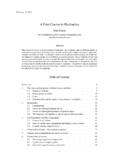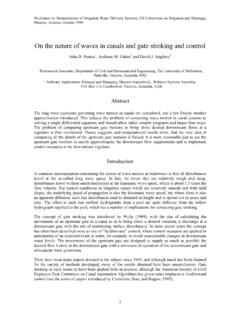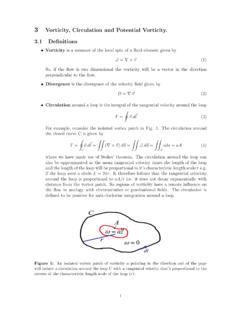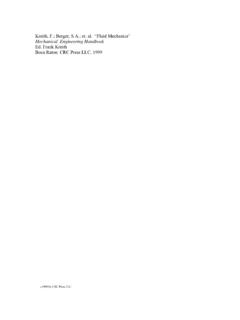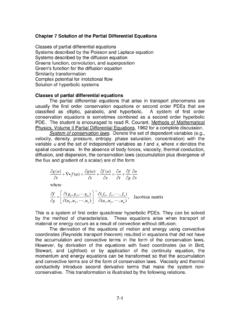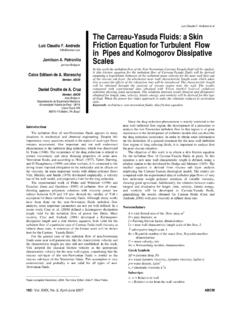Transcription of Nonlinear Wave Theories - John Fenton Homepage
1 The Sea, : Ocean Engineering Science,Eds. B. Le M haut and Hanes, Wiley, New York: 1990 Nonlinear Wave TheoriesJ. D. FentonDepartment of Civil Engineering, University of Auckland,Private Bag, Auckland, New ZealandTable of ..15 References ..161. IntroductionThe general case of water wave motion is where disturbances propagate in varying directions interactingnonlinearly, over water of possible non-uniform density which might beflowing on a shear current,over varying permeable or deformable topography. It is not possible to solve this general problemanalytically. A convenient set of approximations isto assume that locally at least the bed is impermeableandflat, that the propagation of disturbances is collinear and they are of infinite length transverse tothe direction of propagation such that theflow is two-dimensional, that thefluid is homogeneous andincompressible, and that the boundary layer is small such that inviscidflow theory can be used.
2 Underthese approximations it is possible to obtain analytical solutions which correspond to a single periodicwave train which propagates steadily without change of form. This is the steady wave problem, and agreat deal of attention has been given to it as it hasbeen considered to be an important and convenientmodel for the more general one. A recent detailed presentation of common methods has been given bySobeyet al.(1987).It is possible to obtain Nonlinear solutions for waves on shearflows for special cases of the vorticitydistribution. For waves on a constant shearflow, Kishida and Sobey (1988), calculated a third-order so-lution, while Dalrymple (1974), used a numerical method.
3 It is conceivable that in future such solutionswill become more important. However, solution for more general shearflowsisdifficult. In many casesthe details of the shearflow are not known, and the irrotational model seems to be adequate for manysituations in the absence of any other this article Theories presented will be limited tothose assuming that theflow is are two main Theories for steady waves which are capable of refinement. Thefirst is Stokestheory, most suitable for waves which are not very long relative to the water depth. The second isCnoidal theory, suitable for the other limit where the waves are long.
4 Both Theories are presented in thefollowing sections. It should be noted that nowhere in the text of this article are the terms "Stokes wave"or "cnoidal wave" used. In each of the two Theories , the waves which being described are steady wavesof progression, and there is no fundamentaldifference between the waves new version of cnoidal theory is presented here, which is rather simpler to apply and which gives verymuch better results forfluid velocities than previous cnoidal Theories . Both Stokes and cnoidal theoriesare presented tofifth order, which is a reasonable compromise; the accuracy is shown to be good, yet theamount of data presented in the form of numerical coefficients is not unreasonable.
5 It is recommendedthat the fullfifth-order theory be used in each case, as once the organisation offirst-order calculations ina systematic manner has been accomplished, the extension tofifth-order involves little more sections on the two main wave Theories are followed by a description of accurate numerical methodsbased on Fourier approximation. These methodsare capable of high accuracy over almost the wholerange of wave heights and lengths. The accuracy of each of the approximate Theories is then examined,in the course of which some new results are obtained. It is suggested that the twofifth-order theoriesjointly are capable of acceptable accuracy over most of the range of possible waves .
6 An empiricalformula for the height of the highest waves is presented and a boundary between the regions of validityof the Theories is proposed. Finally a set of formulae is presented for integral properties of the wavetrain. These contain the results of recent work which correct previous Steady waves : the effects of current and the governing equations ( ) ( ) ( )= ( ) Figure 1. One wave of a steady train, showing principal dimensions and co-ordinates. Fluid velocities are shownunder crest and trough, solid lines show those in the stationary frame, dashed lines show those in the frame of physical dimensions uniquely defineawavetrain: themeandepth , the wave crest-to-troughheight , and wavelength.
7 Many presentations of theory have assumed that the wave period can re-place the wave length as the third parameter identifying a wave train. However in most marine situationswaves travel on afinite current which is determined by oceanographic and topographic factors. Thewave speed relative to an observer depends on the current, such that waves travel faster with the currentthan against it. Contrary to the implicit assumptions of most presentations of steady wave theory, notheory can predict the actual wave speed. What the Theories do predict, however, is the speed of thewaves relative to the existence of a current has two main implications for the application of a steady wave theory.
8 Firstly,the apparent period measured by an observer depends on the actual wave speed and hence on the current,that is, the apparent period is Doppler-shifted. Thismeans that without explicit allowance for the currentin calculations it is not possible to solve the problemuniquely, if, as in many applications, the periodis known instead of the wave length. The second main effect of current is the additive effect it has2on horizontalfluid velocities. To determine these velocities it is necessary to know the current. If thecurrent is not known, then the problem is the wave as shown in Figure 1, with a frame of reference( ), in the direction of propa-gation of the waves and vertically upwards with the origin on theflat bed.
9 The waves travel in the direction at speed relative to this frame. It is this stationary frame which is the usual one of interestfor engineering and geophysical applications. Consider also a frame of reference( )moving withthe waves at velocity , such that = + ,where is time, and = .Thefluidvelocityinthe( )frame is( ), and that in the( )frame is( ). The velocities are related by = + and = .In the( )frame allfluidmotionissteady,andconsistsofaflo w in the negative direction, roughlyof the magnitude of the wave speed, underneath the stationary wave profile. The mean horizontalfluidvelocity in this frame, for a constant value of over one wavelength is denoted by.
10 Itisnegativebecause the apparentflow is in the direction. The velocities in this frame are usually not important,they are used to obtain the solution rather more the stationary frame of reference the time-mean horizontalfluid velocity at any point is denoted by 1, the mean current which a stationary meter would measure. (In some recent papers by the author thesymbol was used for this quantity. The symbol adopted here would seem to be better, as it is a meanof velocities, and the subscript 1 is appropriate as it is related to Stokes first approximation to wavespeed.) Relating the velocities in the two co-ordinate systems gives 1= (1)If 1=0then = , so that in this special case the wave speed is equal to.

